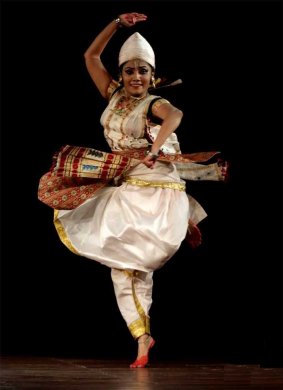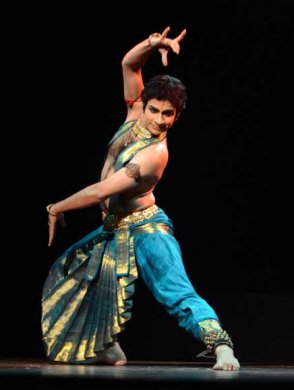
|   |

|   |
Kinkini Dance Festival - Satish Suri e-mail: satishism@yahoo.co.in February 24, 2016 Anwesa Mahanta: Pristine splendour The rich tradition and legacy of Srimanta Sankaradeva were brought to life in the Sattriya dance presentation at the J.S.S Auditorium, Bangalore, on 26th January. Anwesa Mahanta, a noted exponent of the Sattriya dance form, began her program with a Vandana, a sloka invoking Lord Vishnu in “Sri Krishnaya Vasudevaya.” The pure dance sequence “Kali Ramdani” that followed showed the grace and artistry taken from the Prakriti repertoire of Sattriya dance. The music set in kirtana tradition and taal chutkala provided the lyrical splendor of the composition. Anwesa’s rendition was of effortless grace and fluidity, the colourful costume adding visual appeal and intrinsic beauty to the tradition of the dance form.  Anwesa Mahanta Pic: Ravi Shankar The abhinaya piece Geetar Nach or elaboration of geet, a composition of Sankaradeva’s Srimad Bhagavata explores the eight virtues of Goddess Lakshmi, the eight gunas in a symbolic way.The narrative elaborates the various deeds of Vishnu in sancharis followed by Lakshmi Swayamwar, the marriage of Lakshmi with Vishnu. In this piece, the intense bhakti of Vipra Damodhar (Sudhama) is seen through the meeting of Sudhama and Krishna.The three blessings of the Earth, Heaven and the entire Tribhuvan are given by Krishna to Sudhama. Lakshmi then removes the pot and takes in all as a measure of conservation of the future. Bhakti was the predominant factor that permeated every aspect of her rendition be it her abhinaya, the bhangi and the hastas that she used with delicate finesse. The concluding piece “Nrsimha Leela” taken from Sankaradeva’s Prahlada Charitra of Kirtana Ghosa depicts the fury of Hiranyakashipu towards his son Prahlada who refuses to surrender to his father. His attempts to kill him by throwing him from the mountain top or asking him to take the venom of a serpent or being crushed under the heels of an elephant prove to be futile. Finally, he questions Prahlada about the omnipotence of the Lord, and when finally he breaks the pillar to find Narasimha who kills him. Overwhelmed by the devotion of Prahlada the Lord blesses him and returns to his normal state. Comprehensive communication and dramatic presentation of the killing of Hiranyakasipu left the audience with an artistic experience to relish. The accompaniment consisting of Hari Prasad Saikia (khol), Anil Iyer (cymbals), Rituparna Ghosh Baruah (vocal) and Bhupen Rajbongshi (flute) forming an integral part of the presentation enhanced the appeal of the performance. Pavitra Bhat: Youthful exuberance Pavitra Bhat’s first margam in Bangalore on 27th January bristled with energy and youthful eloquence. His alarippu in misra jati set the tone executing the geometric patterns with excellent timing and rhythm revealing the beauty and choreography of Kadirvelu Pillai. The varnam “Devadi Deva Nataraja,” a composition of Veena Seshanna set to Shanmukhapriya and adi talam provided ample scope for a power packed expressive display by the artist. Describing the five sabhas, Ravana playing the veena with strings made out of his gut, and Nandanar’s devotion were vividly captured. The visualisation of “Chidambaram nathane kanaka sabeshhane” had all the markings of an accomplished dancer. The physical vitality clearly poured out of the sinews as the rendition was marked by clear cut lines, and energetic leaps that covered the stage space. There was a overwhelming sense of power in the execution of the nritta segments which probably stands to the advantage of the male artist. The jati rendition by Kaleswaran Kadirvelu Pillai provided the necessary flourish to the presentation.  Pavitra Bhat Pic: Aashrith Mallur The Marathi abang of Sant Tukaram in Hindolam “Sawale sundar roop Manohar” described the bhakti and devotion of the Gopis to Lord Krishna. The mood and tone of the rasa was adequately presented. The scintillating thillana in Brindavanasaranga raga,composed by Madurai N Krishnan provided a fitting finale in terms of technical virtuosity and purity. The soundscape with R. Raguram (vocals), K. Jayaram (flute), Lingaraju (mridangam) and Kaleswaran Kadirvelu Pillai (nattuvangam) enriched his performance with perfect synchronisation. Bangalore based Satish Suri is an avid dance rasika besides being a life member of the Music and Arts Society. |